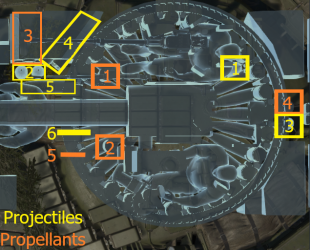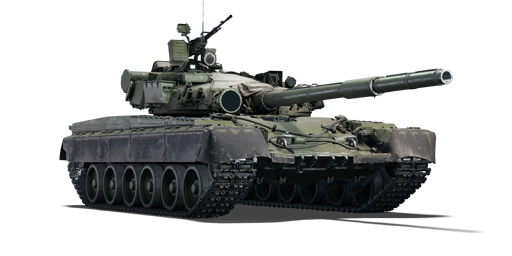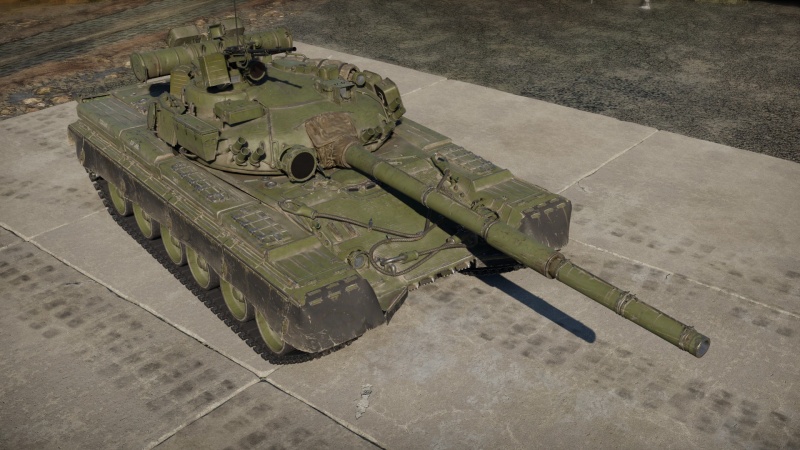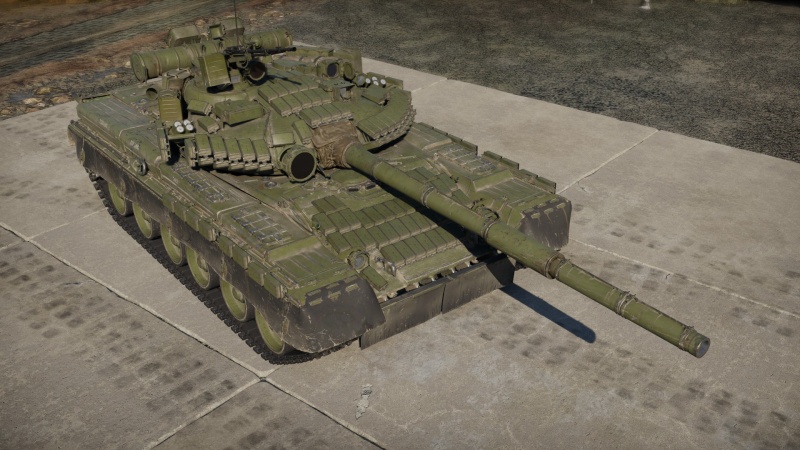T-80B
| This page is about the Soviet medium tank T-80B. For other versions, see T-80 (Family). |
Contents
Description
The T-80B (Object 219R) was one of the spearhead MBTs of the Soviet Union built by the Leningrad Kirov Plant and Omsk Transmash. The Soviet Union had been developing gas turbine engines for tanks as early as 1955, and previous efforts before the T-80 became valuable experience for future engines. After the development of the costly T-64 series MBT, there were plans from other tank design bureaus and factories to upgrade the T-64A with a gas turbine engine and new suspension that could withstand the operational needs of the tank. This led to the Object 219 prototypes, and later tests with the second certified prototype (Object 219 Sp2) alongside the Object 172M (T-72) and T-64A showed superiority in terms of mobility. The Object 219 almost failed to join the Soviet Army due to its high fuel consumption and low reliability, but changes in leadership saved the project, where the soon-to-be T-80 would become the spearhead of the Soviet Army while the T-72 would serve as the economical alternative to previous fleets of tanks. The T-80B series received technological upgrades based on the T-64B, including improved FCS for gun-launched ATGMs, as well as the new "K" ceramic composite armour for better protection. Starting its production in 1976, the T-80B, alongside the later T-80BV with revised protection and Kontakt-1 ERA, has served as the spearhead of the Soviet armoured corps with fleets of T-80U as well. The tank is still serving the Russian Army, accompanied with its latest upgrade T-80BVM with overhaul upgrades on protection and FCS.
Introduced in Update 1.81 "The Valkyries", the T-80B is visually similar to the T-64B, retaining the same rounded turret, sloped frontal armour, and skirted sides, as well as the same jacketed 125 mm smoothbore gun. The turret bears different kit, however, such as the use of rounded storage bins and a snorkel tube. The same NSVT 12.7 mm machine gun is fitted, but this time it is used with 150-round boxes instead of the 100-round boxes found on the T-64B. The T-80B retains the same rubber-mesh screens covering the upper portion of the tracks. The frontal glacis has an additional 30 mm plate of HHRA welded onto it. This replaces the regular V-shaped "splash plate" found on the T-64B. The primary difference between the T-80B and its predecessor is the significantly improved engine which offers increased mobility.
General info
Survivability and armour
The T-80B encounters the same weaknesses and strengths as the T-64 line does - extremely strong turret cheeks, an average upper front glacis with a large weak spot around the driver's port, and a lack of composite on the lower front plate. It's also vulnerable to the same incoming fire as the T-64B - turret shots will often disable the gun breech; penetrating shots on the hull will often detonate the ammunition in the carousel.
As with the T-64B, the T-80B is best used in hull-down positions where only the turret is exposed - and unlike the T-64B, it has an acceptable reverse speed for utilising cover.
Mobility
| Game Mode | Max Speed (km/h) | Weight (tons) | Engine power (horsepower) | Power-to-weight ratio (hp/ton) | |||
|---|---|---|---|---|---|---|---|
| Forward | Reverse | Stock | Upgraded | Stock | Upgraded | ||
| Arcade | 78 | 13 | 42.5 | 1,705 | 2,099 | 40.12 | 49.39 |
| Realistic | 70 | 11 | 973 | 1,100 | 22.89 | 25.88 | |
The T-80B has a turbine engine which produces significantly more power than the T-64B's diesel - top speed and manoeuvrability are both improved thanks to this but the most significant change is the acceleration - the T-80B is able to achieve reasonable speeds both off- and on-road and maintain them much better than the T-64B. More importantly, the reverse speed is nearly tripled from the measly -4 km/h on the T-64B to -11 km/h, still not ideal but a big improvement.
Thanks to the improvements, the T-80B is a much better match for the Abrams/Challenger/Leopard series - it's still not the fastest but it's a much closer race.
Modifications and economy
Armaments
Main armament
| 125 mm 2A46M-1 | Turret rotation speed (°/s) | Reloading rate (seconds) | |||||||||||
|---|---|---|---|---|---|---|---|---|---|---|---|---|---|
| Mode | Capacity | Vertical | Horizontal | Stabilizer | Stock | Upgraded | Full | Expert | Aced | Stock | Full | Expert | Aced |
| Arcade | 38 | -5°/+15° | ±180° | Two-plane | 22.8 | 31.6 | 38.4 | 42.5 | 45.2 | 7.10 | 7.10 | 7.10 | 7.10 |
| Realistic | 14.3 | 16.8 | 20.4 | 22.6 | 24.0 | ||||||||
Ammunition
| Penetration statistics | |||||||
|---|---|---|---|---|---|---|---|
| Ammunition | Type of warhead |
Penetration @ 0° Angle of Attack (mm) | |||||
| 10 m | 100 m | 500 m | 1,000 m | 1,500 m | 2,000 m | ||
| 3BK18M | HEATFS | 550 | 550 | 550 | 550 | 550 | 550 |
| 3OF26 | HE | 42 | 42 | 42 | 42 | 42 | 42 |
| 3BM22 | APFSDS | 425 | 420 | 415 | 405 | 393 | 380 |
| 9M112 | ATGM | 650 | 650 | 650 | 650 | 650 | 650 |
| 3BM42 | APFSDS | 457 | 454 | 445 | 431 | 419 | 406 |
| Shell details | ||||||||||||
|---|---|---|---|---|---|---|---|---|---|---|---|---|
| Ammunition | Type of warhead |
Velocity (m/s) |
Projectile mass (kg) |
Fuse delay (m) |
Fuse sensitivity (mm) |
Explosive mass (TNT equivalent) (kg) |
Ricochet | |||||
| 0% | 50% | 100% | ||||||||||
| 3BK18M | HEATFS | 905 | 19 | 0.05 | 0.1 | 2.79 | 65° | 72° | 77° | |||
| 3OF26 | HE | 850 | 23 | 0.3 | 0.1 | 5.24 | 79° | 80° | 81° | |||
| 3BM22 | APFSDS | 1,760 | 4.83 | - | - | - | 76° | 77° | 80° | |||
| 3BM42 | APFSDS | 1,700 | 4.85 | - | - | - | 78° | 80° | 81° | |||
| Missile details | ||||||||||||
|---|---|---|---|---|---|---|---|---|---|---|---|---|
| Ammunition | Type of warhead |
Velocity (m/s) |
Range (m) |
Projectile mass (kg) |
Fuse delay (m) |
Fuse sensitivity (mm) |
Explosive mass (TNT equivalent) (kg) |
Ricochet | ||||
| 0% | 50% | 100% | ||||||||||
| 9M112 | ATGM | 400 | 5,000 | 27.5 | 0.05 | 0.1 | 5.72 | 80° | 82° | 90° | ||
Ammo racks

| Full ammo |
Ammo part |
1st rack empty |
2nd rack empty |
3rd rack empty |
4th rack empty |
5th rack empty* |
6th rack empty* |
Visual discrepancy |
|---|---|---|---|---|---|---|---|---|
| 38 | Projectiles Propellants |
38 (+0) 38 (+0) |
36 (+2) 37 (+1) |
35 (+3) 30 (+8) |
30 (+8) 29 (+9) |
29 (+9) 1 (+37) |
1 (+37) N/A |
No |
Notes:
- The T-80B main ammo rack consists of a mechanized carousel at the bottom of the turret. Such ammo stowage carries 28 propellants and projectiles.
- The 6th projectile rack is the carousel at the bottom of the turret; it serves as first-stage ammo stowage.
- The 5th propellant rack is the carousel at the bottom of the turret; it serves as first-stage ammo stowage.
Machine guns
| 12.7 mm NSVT | ||||
|---|---|---|---|---|
| Mount | Capacity (Belt) | Fire rate | Vertical | Horizontal |
| Pintle | 300 (150) | 700 | -5°/+75° | ±180° |
| 7.62 mm PKT | ||||
|---|---|---|---|---|
| Mount | Capacity (Belt) | Fire rate | Vertical | Horizontal |
| Coaxial | 1,250 (250) | 700 | N/A | N/A |
Usage in battles
The T-80B should be played like a T-64B, using your powerful gun and decent armour to pick off enemies in the distance. When needed, the T-80B can perform flanking runs with its decent speed. However, the T-80B should not be played like an M1 Abrams, as the tank will explode when anything penetrates your armour.
When playing in large maps such as "Kursk" and "Maginot Line" use the mobility of the T-80B to get into a hull-down position and make use of the T-80B's armament as well as its phenomenal turret armour to pick-off faraway enemy tanks. When playing in small maps such as "Normandy" and "Poland", use the mobility of the T-80B to flank enemy tanks as you would with the "M1 Abrams" or similar western MBT.
Make sure to always keep your front facing the enemy, when any top BR vehicle gets a glance at your side the round will penetrate through the fairly weak side armour and have a good chance at hitting your ammo rack or your engine which will result in a loss of the vehicle or a critical hit to the vehicle's powerplant. The T-80B has fairly poor gun handling compared to its western counterparts in both the gun elevation and traverse speeds, which can get you destroyed or severely damaged in close range engagements.
Some threats to be worried about:
- Type 90 can penetrate any part of your tank and any plausible range. So don't get hit by it. The same goes for AMX-40.
- An ATGM will result in an ammunition detonation or crew kill. It is extremely important to get the Kontakt-1 ERA modification as soon as possible because those ERA blocks will save you from helicopters. If you do not have the ERA modification, pay attention to the skies, try to maintain some sort of cover, as you will usually have 1-3 seconds of reaction time from detecting an ATGM and getting hit by one.
Pros and cons
Pros:
- Very good composite armour
- Powerful main gun with great stabilizers and accuracy
- Very good mobility
- Small vehicle
- Decent reverse speed of 12 km/h
- Autoloader like the T-64
- Good chemical munitions protection with the ERA upgrade
- Has access to thermal vision
Cons:
- Same autoloader as the T-64, same rate of fire and weak spot
- 3 crew member makes it hard to survive on the battlefield
- Bad gun depression, the generic trouble of Soviet tanks
- Not a very fast turning turret
- Lower frontal hull armour devoid of composite armour
- Breech is easily damaged
History
The T-80B is an improved variant of the T-80 main battle tank that debuted in 1978. It received a laser rangefinder, a new fire-control system, and a new autoloader; these modifications allowed the firing of 9M112-1 Kobra anti-tank guided missiles. The ATGMs could be launched at any speed, and they were fired out of the gun barrel. The T-80B also featured new composite armour. In 1980, the T-80B received a new 1,100 hp engine. In 1982 a new gun was fitted, and fittings for ERA were added in 1985. The ERA increased protection against chemical warheads significantly, at an estimated 400 mm of additional chemical protection.
The T-80B was not used in Afghanistan during the 1980s in order to keep it a secret from the Western nations. Its first combat usage was during the First Chechen War. They were used to capture cities, and they often suffered casualties because of how dangerous urban environments are for tanks. Many T-80B tanks were lost during the attack on Grozny, where more than 450 Chechen rebels were killed. Throughout 3 months of combat, 84 T-80 tanks were used. The 133rd Tank Battalion used 53 T-80s and lost 12. The 3rd Tank Battalion used 31 T-80s and lost 6. During that operation, the T-80Bs were crewed with insufficiently trained crews, and the T-80B was not equipped with ERA. The tanks were not prepared for their enemies, some of whom were veterans from the Soviet-Afghan War.
During the war, T-80s fought several tank-to-tank battles. During December of 1994 and January of 1995, Russian T-80 tanks destroyed six rebel tanks. Two T-80s were damaged; one was destroyed by a 125 mm anti-tank round and another was damaged by 3-4 rounds but repaired. One rebel tank was destroyed in August 1995.
During the operation in Grozny, the Russian tank crews had no knowledge of the city's layout. The rebels attacked the tanks with RPGs from cellars and the tops of buildings. The anti-tank attacks were aimed at the weakest points in the armour, and each tank had three to seven RPGs fired at it. A number of tanks exploded with hits to the ammunition in the autoloader. The T-80's performance in these situations prompted General-Lieutenant A. Galkin, the head of the Armored Directorate, to convince the Minister of Defense to never again produce a tank with a gas turbine engine.
After those operations, the T-80 was never again used to capture cities, but instead to support the infantry at long range. It was pointed out that the T-72 performed just as badly in those situations, and additionally the tanks had been deployed without supporting infantry to cover them. The crews were also insufficiently trained. It has been said that these factors influenced the outcome of the operations more than the characteristics of the tank.
Media
- Skins
- Videos
See also
Links to the articles on the War Thunder Wiki that you think will be useful for the reader, for example:
- reference to the series of the vehicles;
- links to approximate analogues of other nations and research trees.
External links
| Leningrad Kirov Plant (Ленинградский Кировский Завод) | |
|---|---|
| Medium Tanks | |
| T-28 | T-28 (1938) · T-28 · T-28E |
| T-80 | T-80B · T-80U · T-80UK · T-80BVM |
| Heavy Tanks | |
| KV-1 | KV-1 (L-11) · KV-1 (ZiS-5) · KV-1E · KV-1S |
| KV-2 | KV-2 (1939) · KV-2 (1940) · KV-2 (ZiS-6) |
| Other | SMK · KV-220 · IS-7 · Object 279 |
| Captured | |
| KV | ▀KV-IB · ▀KW I C 756 (r) · ▀KW II 754 (r) |
| Other | T-28 (Sweden) |
| Export | T-80U (Sweden) |
| See Also | Chelyabinsk Tractor Plant |
| USSR medium tanks | |
|---|---|
| T-28 | T-28 (1938) · T-28 · T-28E |
| T-34-76 | T-34 (Prototype) · T-34 (1940) · T-34 (1941) · T-34 (1st Gv.T.Br.) · T-34 (1942) · T-34E STZ · T-34E |
| T-34-57 | T-34-57 · T-34-57 (1943) |
| T-34-85 | T-34-85 (D-5T) · T-34-85 · T-34-85E |
| T-34-100 | T-34-100 |
| T-44 | T-44 · T-44-100 · T-44-122 |
| T-54 | T-54 (1947) · T-54 (1949) · T-54 (1951) |
| T-55 | TO-55 · T-55A · T-55AM-1 · T-55AMD-1 |
| T-62 | T-62 · T-62M-1 |
| T-64 | Object 435 · T-64A (1971) · T-64B |
| T-72 | T-72A · T-72AV (TURMS-T) · T-72B · T-72B (1989) · T-72B3 · T-72M2 Moderna |
| T-80 | T-80B · T-80U · T-80UD · T-80UK · T-80UM2 · Т-80U-Е1 · T-80BVM · Object 292 |
| T-90 | Т-90А · T-90M |
| Trophies/Lend-Lease | |
| Germany | ▂T-III · ▂T-V |
| Great Britain | ▂МК-IX "Valentine" |
| USA | ▂M3 Medium · ▂M4A2 |
- Ground vehicles
- USSR ground vehicles
- Seventh rank ground vehicles
- Medium tanks
- Ground vehicles with explosive reactive armour
- Ground vehicles with composite armour
- Ground vehicles with smoke grenades
- Ground vehicles with engine smoke generating system
- Ground vehicles with dozer blade
- Ground vehicles with thermal sight
- Ground vehicles with autoloader
- Ground vehicles with gun stabilizer
- ATGM vehicles






